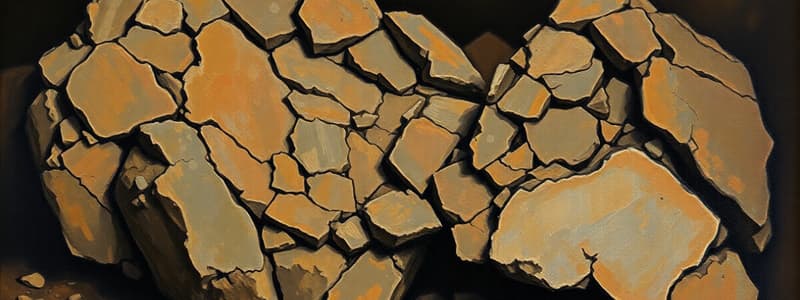Podcast
Questions and Answers
What is the primary distinction between intrusive and volcanic rocks?
What is the primary distinction between intrusive and volcanic rocks?
- Volcanic rocks are formed from lava, while intrusive rocks are formed from sediments.
- Volcanic rocks are always crystalline, while intrusive rocks are always glassy.
- Intrusive rocks form on the surface, while volcanic rocks form underground.
- Intrusive rocks cool slowly underground, while volcanic rocks cool rapidly on the surface. (correct)
Which process primarily leads to the formation of volcanic rocks?
Which process primarily leads to the formation of volcanic rocks?
- Metamorphism of pre-existing rocks.
- Decomposition of organic materials over time.
- Melting of ice under extreme pressure.
- Cooling and solidification of magma on the Earth's surface. (correct)
Which of the following is NOT a characteristic feature of intrusive igneous rocks?
Which of the following is NOT a characteristic feature of intrusive igneous rocks?
- Coarse-grained texture.
- Presence of large crystals.
- Rapid cooling resulting in a glassy appearance. (correct)
- Formation at deep crustal levels.
Which type of rock is formed from magma that does not reach the surface?
Which type of rock is formed from magma that does not reach the surface?
What is the expected texture of volcanic rocks compared to intrusive rocks?
What is the expected texture of volcanic rocks compared to intrusive rocks?
What is a common characteristic that differentiates intrusive igneous rocks from volcanic rocks?
What is a common characteristic that differentiates intrusive igneous rocks from volcanic rocks?
Which scenario would most likely result in the formation of volcanic rocks?
Which scenario would most likely result in the formation of volcanic rocks?
Which of the following best describes the cooling rate of intrusive igneous rocks?
Which of the following best describes the cooling rate of intrusive igneous rocks?
What type of environment is most likely to produce intrusive igneous rocks?
What type of environment is most likely to produce intrusive igneous rocks?
Which is NOT commonly associated with volcanic rocks?
Which is NOT commonly associated with volcanic rocks?
Flashcards are hidden until you start studying
Study Notes
Intrusive vs. Volcanic Rocks
- Intrusive rocks form when magma cools and solidifies beneath the Earth's surface.
- Volcanic rocks form when lava, which is magma that reaches the Earth's surface, cools and solidifies.
Formation of Volcanic Rocks
- The primary process leading to the formation of volcanic rocks is the eruption of lava onto the Earth's surface.
Characteristics of Intrusive Rocks
- Coarse-grained texture is a characteristic feature of intrusive igneous rocks. This means the crystals have large, visible grains.
Intrusive Igneous Rocks
- Intrusive igneous rocks are formed from magma that does not reach the surface and cools slowly underground.
Texture Comparison
- Volcanic rocks typically have a fine-grained or glassy texture due to rapid cooling, while intrusive rocks have a coarse-grained texture because they cool slowly.
Distinguishing Intrusive and Volcanic Rocks
- A common characteristic that differentiates intrusive igneous rocks from volcanic rocks is the size of their crystals.
Formation of Volcanic Rocks
- Volcanic eruptions are the most likely scenario to result in the formation of volcanic rocks.
Cooling Rates
- Intrusive igneous rocks cool slowly, allowing for the formation of large crystals.
Formation Environment
- Intrusive igneous rocks are most likely to form in deep underground environments.
Features of Volcanic Rocks
- Fine-grained texture is a characteristic feature of volcanic rocks, which is often associated with rapid cooling.
Intrusive vs. Volcanic Rocks
- Intrusive rocks solidify from magma beneath the Earth's surface.
- Volcanic rocks solidify from lava that erupts onto the Earth's surface.
- Volcanic rocks are formed through the process of volcanism (eruption of lava)
Characteristics of Intrusive and Volcanic Rocks
- Intrusive rocks typically have larger crystals due to slower cooling rates.
- Volcanic rocks typically have smaller crystals due to faster cooling rates.
- Intrusive rocks are commonly found in deep underground environments.
- Volcanic rocks often contain vesicles (air pockets) due to the escape of gases during eruption.
Identifying Features
- Intrusive rocks are characterized by coarse-grained textures.
- Volcanic rocks are characterized by fine-grained or glassy textures.
- Intrusive rocks typically show well-defined crystal shapes.
- Volcanic rocks may show porosity due to trapped gas bubbles during eruption.
Studying That Suits You
Use AI to generate personalized quizzes and flashcards to suit your learning preferences.




